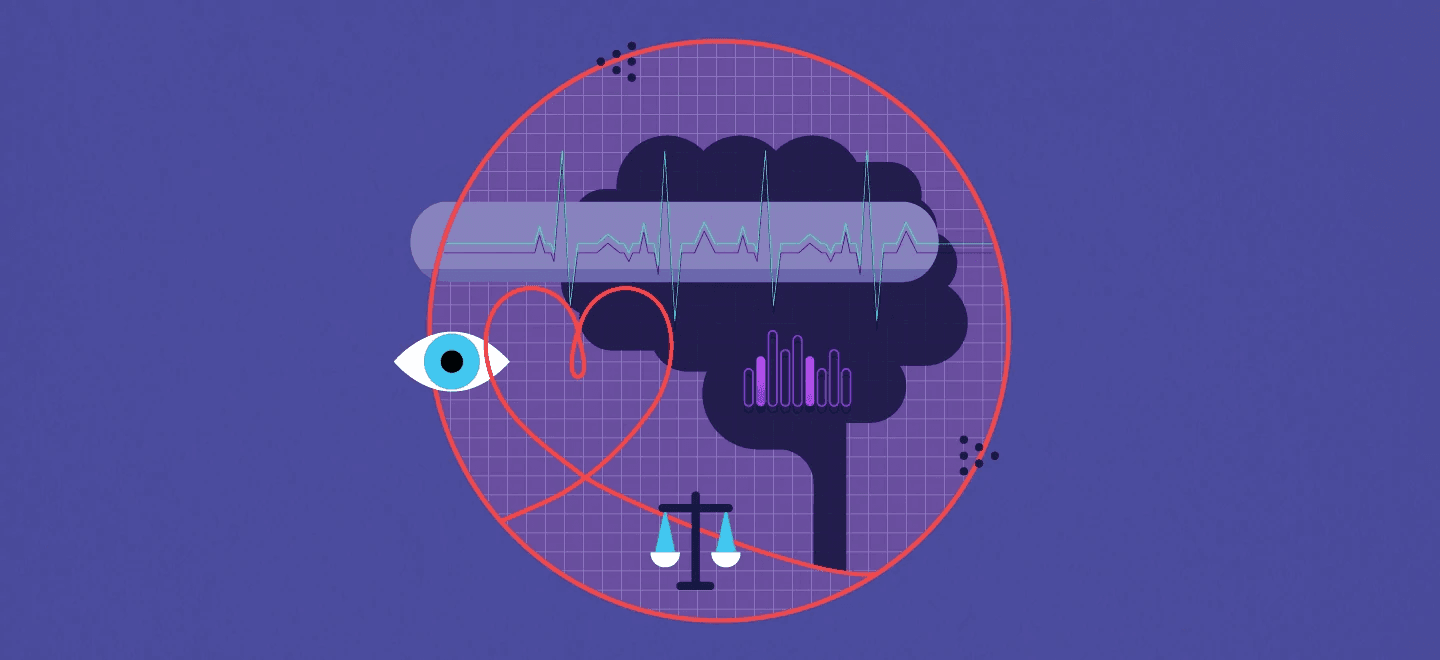BRAINS VS VIRUS - Study updates
Quoc Minh Lai
Oct 13, 2020
Share:



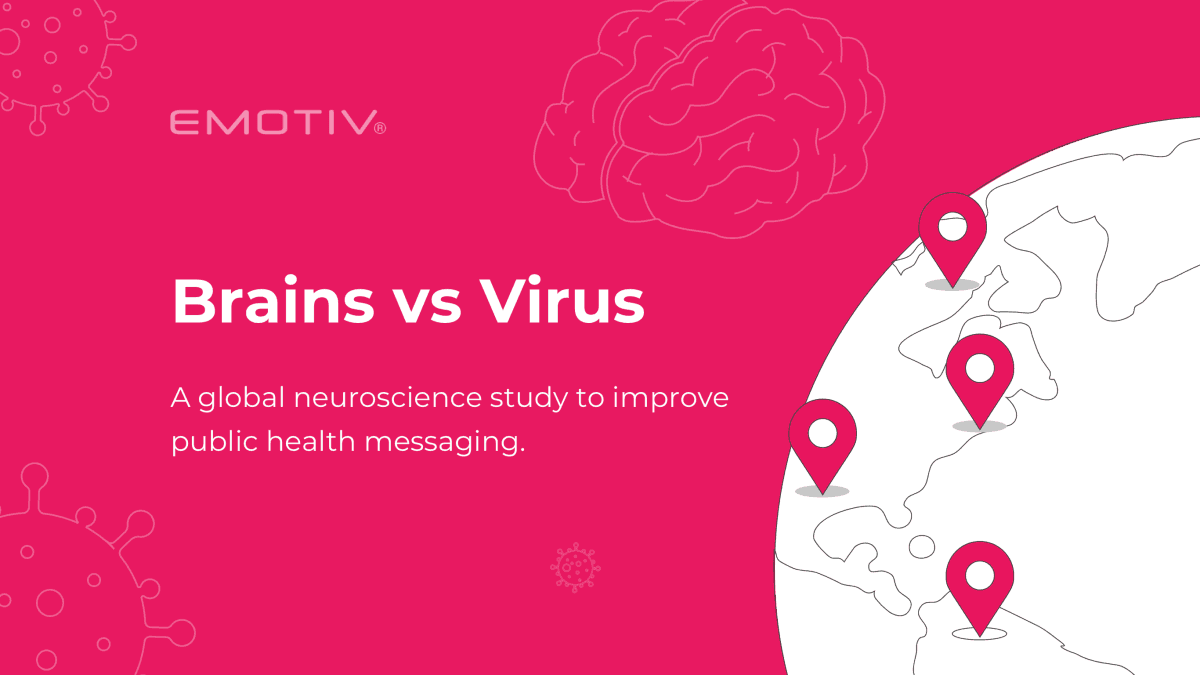

Public health communication strategies are too important not to be informed by rigorous science. This is why we launched BRAINSvsVIRUS: a non-commercial study leveraging EMOTIV’s brand-new remote brain data collection platform to better understand how people process COVID-related information shared by public health authorities and provide unique insights on the level of stress experienced by people at home.
For the past 8 months, governments and public health agencies around the world have been struggling to convey COVID-related information to people and convince them to change their behaviors to slow down the spread of coronavirus. The harsh reality is that, until a vaccine is found, the only way to slow down the spread of coronavirus is by convincing as many people as possible to not only change their behaviors but to stick to new habits that can save lives. These include washing our hands often, avoiding close contact by observing physical distancing, to cover our mouths and noses with masks, to cover coughs and sneezes, to clean and disinfect surfaces often, and to monitor our health frequently.
In a recent article, Alfred Sommer, former dean of the Johns Hopkins Bloomberg School of Public Health was quoted saying “Public health’s greatest underused tool is educating the public <…> Now, it is playing catch-up during a pandemic“. Communicating public health recommendations and educating the public in times of crisis is not an easy task to say the least. Especially when that pandemic is global and extends over time, with no clear end at the horizon. Even people who do their best to observe COVID-related public health recommendations are generally experiencing “prevention fatigue”: the feeling that prevention messages and measures are tiresome, leading to weariness, people paying less and less attention to public health communications.
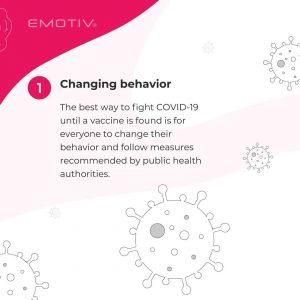
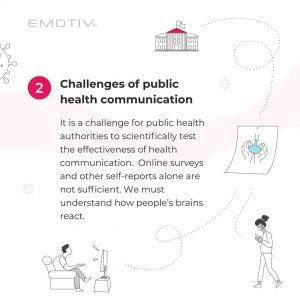

(Click here for full infographics)
One particular issue that has prevented efficient communication about COVID-19 is the lack of rigorous scientific methodology employed when various forms of communication are designed and their impact is tested before being launched. If these messages are tested at all, which is not always the case, unfortunately.
The most common way to test the efficiency of public health messaging is to use methods that rely on self-reports such as questionnaires, surveys and focus groups. These methods are known to be flawed. At best, these methods provide a snapshot of what people think they are going to do or what they think they should be doing. But this is not enough since there is often a gap between what we report when filling surveys and what we do, between our intentions and our actions.
One way to address this gap and better inform public health communication strategies is to use neuroscientific insights in addition to self-reports. In light of studies that have shown that neuroscientific data was a better predictor of which health prevention message would be most impactful on people, for more than a decade now, scientists have been advocating for brain data to be leveraged in public health strategies. Brain data can be particularly useful to better understand how people process public health messages and how the repetition of messaging leads to prevention fatigue.
*
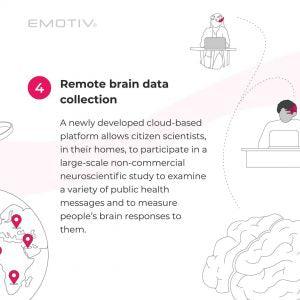
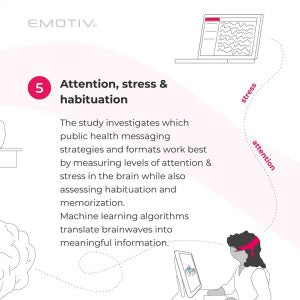

(Click here for full infographics)
But unlike the private sector that has been leveraging neuroscience for more than two decades to better communicate and engage with its consumers and employees, most local and national public health authorities are not equipped with teams of behavioral and brain scientists. Nor do they have access to neurotechnologies that could measure brain reactions of people remotely in their homes, including the changes in the levels of stress truly experienced.
For almost a decade, tens of thousands of people in 120+ countries have been using EMOTIV solutions to conduct research. These people are academic and citizen scientists, industry researchers, designers, R&D leads amongst many other professions. Thanks to the global community of owners and users of EMOTIV brainwear, several thousand published scientific studies have been published (Google Scholar search for “EMOTIV AND EEG” on October 11, 2020). We have therefore engaged our global community to contribute to BRAINSvsVIRUS. Thanks to our proprietary machine learning algorithms we looked at how a variety of public health posters, videos, and messages coming from all over the world impacted the brains of people in their homes.
The brain measures we studied include our levels of cognitive stress, attention, valence, and relaxation. Starting next week, we will be sharing some of our findings.

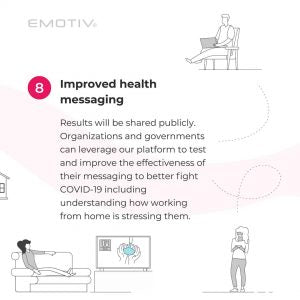

(Click here for full infographics)
Our brains play a key role in the way we process information, influence each other, make decisions, adopt new behaviors, and stick to them. Public health authorities can no longer ignore the benefits of including insights from brain data in designing, launching, and evaluating health communications.
Public health authorities must be leveraging the most advanced (neuro)tech and rigorous (neuro)science available to inform COVID-related communication and stress management strategies in public and private organizations.
When lives are at stakes, (neuro)science matters more than ever.
References:
Sara Brown. A checklist for effective COVID-19 public health messaging. MIT Sloan School of Management. May 8, 2020.
Center for Disease Control. How to Protect Yourself & Others. September 11, 2020.
Emily Falk, Elliot Berkman, Danielle Whalen, Matthew D Lieberman. Neural Activity During Health Messaging Predicts Reductions in Smoking Above and Beyond Self-Report. Health Psychology, March 1, 2011. Volume 30(2). Pages 177-185.
Martin A. Imhof, Ralf Schmälzle, Britta Renner, Harald T. Schupp. How real-life health messages engage our brains: Shared processing of effective anti-alcohol videos. Social Cognitive Affective Neuroscience. July 2017, Volume 12(7), pages 1188-1196.
Olivier Oullier. We can combat the virus by equipping governments with an arsenal of neurotech. The National, March 17, 2020
Olivier Oullier & Sarah Sauneron. Improving public health prevention with behavioural, cognitive and neuroscience. Prime Minister of France: Center for Strategic Analyses. March 16, 2010
Meeta Shah. The Failure of Public Health Messaging about COVID-19. Scientific American, September 3, 2020.
Milan Sharma. Health minister calls out ‘prevention fatigue’, urges for Covid-19 precautions during festivals. India Today. October 4, 2020
Frances Stead Sellers. On social media, influencers put the coronavirus in the spotlight. The Washington Post, June 6, 2020.
Public health communication strategies are too important not to be informed by rigorous science. This is why we launched BRAINSvsVIRUS: a non-commercial study leveraging EMOTIV’s brand-new remote brain data collection platform to better understand how people process COVID-related information shared by public health authorities and provide unique insights on the level of stress experienced by people at home.
For the past 8 months, governments and public health agencies around the world have been struggling to convey COVID-related information to people and convince them to change their behaviors to slow down the spread of coronavirus. The harsh reality is that, until a vaccine is found, the only way to slow down the spread of coronavirus is by convincing as many people as possible to not only change their behaviors but to stick to new habits that can save lives. These include washing our hands often, avoiding close contact by observing physical distancing, to cover our mouths and noses with masks, to cover coughs and sneezes, to clean and disinfect surfaces often, and to monitor our health frequently.
In a recent article, Alfred Sommer, former dean of the Johns Hopkins Bloomberg School of Public Health was quoted saying “Public health’s greatest underused tool is educating the public <…> Now, it is playing catch-up during a pandemic“. Communicating public health recommendations and educating the public in times of crisis is not an easy task to say the least. Especially when that pandemic is global and extends over time, with no clear end at the horizon. Even people who do their best to observe COVID-related public health recommendations are generally experiencing “prevention fatigue”: the feeling that prevention messages and measures are tiresome, leading to weariness, people paying less and less attention to public health communications.



(Click here for full infographics)
One particular issue that has prevented efficient communication about COVID-19 is the lack of rigorous scientific methodology employed when various forms of communication are designed and their impact is tested before being launched. If these messages are tested at all, which is not always the case, unfortunately.
The most common way to test the efficiency of public health messaging is to use methods that rely on self-reports such as questionnaires, surveys and focus groups. These methods are known to be flawed. At best, these methods provide a snapshot of what people think they are going to do or what they think they should be doing. But this is not enough since there is often a gap between what we report when filling surveys and what we do, between our intentions and our actions.
One way to address this gap and better inform public health communication strategies is to use neuroscientific insights in addition to self-reports. In light of studies that have shown that neuroscientific data was a better predictor of which health prevention message would be most impactful on people, for more than a decade now, scientists have been advocating for brain data to be leveraged in public health strategies. Brain data can be particularly useful to better understand how people process public health messages and how the repetition of messaging leads to prevention fatigue.
*



(Click here for full infographics)
But unlike the private sector that has been leveraging neuroscience for more than two decades to better communicate and engage with its consumers and employees, most local and national public health authorities are not equipped with teams of behavioral and brain scientists. Nor do they have access to neurotechnologies that could measure brain reactions of people remotely in their homes, including the changes in the levels of stress truly experienced.
For almost a decade, tens of thousands of people in 120+ countries have been using EMOTIV solutions to conduct research. These people are academic and citizen scientists, industry researchers, designers, R&D leads amongst many other professions. Thanks to the global community of owners and users of EMOTIV brainwear, several thousand published scientific studies have been published (Google Scholar search for “EMOTIV AND EEG” on October 11, 2020). We have therefore engaged our global community to contribute to BRAINSvsVIRUS. Thanks to our proprietary machine learning algorithms we looked at how a variety of public health posters, videos, and messages coming from all over the world impacted the brains of people in their homes.
The brain measures we studied include our levels of cognitive stress, attention, valence, and relaxation. Starting next week, we will be sharing some of our findings.



(Click here for full infographics)
Our brains play a key role in the way we process information, influence each other, make decisions, adopt new behaviors, and stick to them. Public health authorities can no longer ignore the benefits of including insights from brain data in designing, launching, and evaluating health communications.
Public health authorities must be leveraging the most advanced (neuro)tech and rigorous (neuro)science available to inform COVID-related communication and stress management strategies in public and private organizations.
When lives are at stakes, (neuro)science matters more than ever.
References:
Sara Brown. A checklist for effective COVID-19 public health messaging. MIT Sloan School of Management. May 8, 2020.
Center for Disease Control. How to Protect Yourself & Others. September 11, 2020.
Emily Falk, Elliot Berkman, Danielle Whalen, Matthew D Lieberman. Neural Activity During Health Messaging Predicts Reductions in Smoking Above and Beyond Self-Report. Health Psychology, March 1, 2011. Volume 30(2). Pages 177-185.
Martin A. Imhof, Ralf Schmälzle, Britta Renner, Harald T. Schupp. How real-life health messages engage our brains: Shared processing of effective anti-alcohol videos. Social Cognitive Affective Neuroscience. July 2017, Volume 12(7), pages 1188-1196.
Olivier Oullier. We can combat the virus by equipping governments with an arsenal of neurotech. The National, March 17, 2020
Olivier Oullier & Sarah Sauneron. Improving public health prevention with behavioural, cognitive and neuroscience. Prime Minister of France: Center for Strategic Analyses. March 16, 2010
Meeta Shah. The Failure of Public Health Messaging about COVID-19. Scientific American, September 3, 2020.
Milan Sharma. Health minister calls out ‘prevention fatigue’, urges for Covid-19 precautions during festivals. India Today. October 4, 2020
Frances Stead Sellers. On social media, influencers put the coronavirus in the spotlight. The Washington Post, June 6, 2020.
Public health communication strategies are too important not to be informed by rigorous science. This is why we launched BRAINSvsVIRUS: a non-commercial study leveraging EMOTIV’s brand-new remote brain data collection platform to better understand how people process COVID-related information shared by public health authorities and provide unique insights on the level of stress experienced by people at home.
For the past 8 months, governments and public health agencies around the world have been struggling to convey COVID-related information to people and convince them to change their behaviors to slow down the spread of coronavirus. The harsh reality is that, until a vaccine is found, the only way to slow down the spread of coronavirus is by convincing as many people as possible to not only change their behaviors but to stick to new habits that can save lives. These include washing our hands often, avoiding close contact by observing physical distancing, to cover our mouths and noses with masks, to cover coughs and sneezes, to clean and disinfect surfaces often, and to monitor our health frequently.
In a recent article, Alfred Sommer, former dean of the Johns Hopkins Bloomberg School of Public Health was quoted saying “Public health’s greatest underused tool is educating the public <…> Now, it is playing catch-up during a pandemic“. Communicating public health recommendations and educating the public in times of crisis is not an easy task to say the least. Especially when that pandemic is global and extends over time, with no clear end at the horizon. Even people who do their best to observe COVID-related public health recommendations are generally experiencing “prevention fatigue”: the feeling that prevention messages and measures are tiresome, leading to weariness, people paying less and less attention to public health communications.



(Click here for full infographics)
One particular issue that has prevented efficient communication about COVID-19 is the lack of rigorous scientific methodology employed when various forms of communication are designed and their impact is tested before being launched. If these messages are tested at all, which is not always the case, unfortunately.
The most common way to test the efficiency of public health messaging is to use methods that rely on self-reports such as questionnaires, surveys and focus groups. These methods are known to be flawed. At best, these methods provide a snapshot of what people think they are going to do or what they think they should be doing. But this is not enough since there is often a gap between what we report when filling surveys and what we do, between our intentions and our actions.
One way to address this gap and better inform public health communication strategies is to use neuroscientific insights in addition to self-reports. In light of studies that have shown that neuroscientific data was a better predictor of which health prevention message would be most impactful on people, for more than a decade now, scientists have been advocating for brain data to be leveraged in public health strategies. Brain data can be particularly useful to better understand how people process public health messages and how the repetition of messaging leads to prevention fatigue.
*



(Click here for full infographics)
But unlike the private sector that has been leveraging neuroscience for more than two decades to better communicate and engage with its consumers and employees, most local and national public health authorities are not equipped with teams of behavioral and brain scientists. Nor do they have access to neurotechnologies that could measure brain reactions of people remotely in their homes, including the changes in the levels of stress truly experienced.
For almost a decade, tens of thousands of people in 120+ countries have been using EMOTIV solutions to conduct research. These people are academic and citizen scientists, industry researchers, designers, R&D leads amongst many other professions. Thanks to the global community of owners and users of EMOTIV brainwear, several thousand published scientific studies have been published (Google Scholar search for “EMOTIV AND EEG” on October 11, 2020). We have therefore engaged our global community to contribute to BRAINSvsVIRUS. Thanks to our proprietary machine learning algorithms we looked at how a variety of public health posters, videos, and messages coming from all over the world impacted the brains of people in their homes.
The brain measures we studied include our levels of cognitive stress, attention, valence, and relaxation. Starting next week, we will be sharing some of our findings.



(Click here for full infographics)
Our brains play a key role in the way we process information, influence each other, make decisions, adopt new behaviors, and stick to them. Public health authorities can no longer ignore the benefits of including insights from brain data in designing, launching, and evaluating health communications.
Public health authorities must be leveraging the most advanced (neuro)tech and rigorous (neuro)science available to inform COVID-related communication and stress management strategies in public and private organizations.
When lives are at stakes, (neuro)science matters more than ever.
References:
Sara Brown. A checklist for effective COVID-19 public health messaging. MIT Sloan School of Management. May 8, 2020.
Center for Disease Control. How to Protect Yourself & Others. September 11, 2020.
Emily Falk, Elliot Berkman, Danielle Whalen, Matthew D Lieberman. Neural Activity During Health Messaging Predicts Reductions in Smoking Above and Beyond Self-Report. Health Psychology, March 1, 2011. Volume 30(2). Pages 177-185.
Martin A. Imhof, Ralf Schmälzle, Britta Renner, Harald T. Schupp. How real-life health messages engage our brains: Shared processing of effective anti-alcohol videos. Social Cognitive Affective Neuroscience. July 2017, Volume 12(7), pages 1188-1196.
Olivier Oullier. We can combat the virus by equipping governments with an arsenal of neurotech. The National, March 17, 2020
Olivier Oullier & Sarah Sauneron. Improving public health prevention with behavioural, cognitive and neuroscience. Prime Minister of France: Center for Strategic Analyses. March 16, 2010
Meeta Shah. The Failure of Public Health Messaging about COVID-19. Scientific American, September 3, 2020.
Milan Sharma. Health minister calls out ‘prevention fatigue’, urges for Covid-19 precautions during festivals. India Today. October 4, 2020
Frances Stead Sellers. On social media, influencers put the coronavirus in the spotlight. The Washington Post, June 6, 2020.
Solutions
Support
Company

© 2025 EMOTIV, All rights reserved.

Your Privacy Choices (Cookie Settings)
*Disclaimer – EMOTIV products are intended to be used for research applications and personal use only. Our products are not sold as Medical Devices as defined in EU directive 93/42/EEC. Our
products are not designed or intended to be used for diagnosis or treatment of disease.
Solutions
Support
Company

© 2025 EMOTIV, All rights reserved.

Your Privacy Choices (Cookie Settings)
*Disclaimer – EMOTIV products are intended to be used for research applications and personal use only. Our products are not sold as Medical Devices as defined in EU directive 93/42/EEC. Our
products are not designed or intended to be used for diagnosis or treatment of disease.
Solutions
Support
Company

© 2025 EMOTIV, All rights reserved.

Your Privacy Choices (Cookie Settings)
*Disclaimer – EMOTIV products are intended to be used for research applications and personal use only. Our products are not sold as Medical Devices as defined in EU directive 93/42/EEC. Our
products are not designed or intended to be used for diagnosis or treatment of disease.
